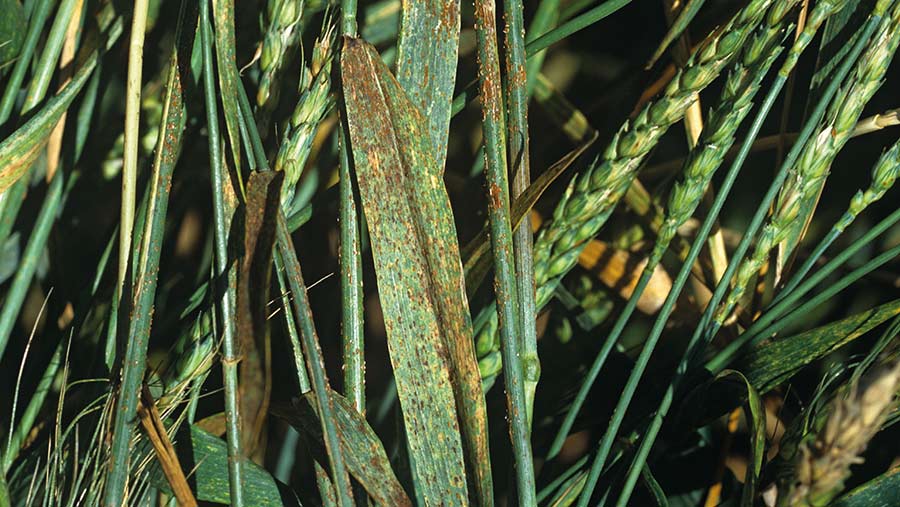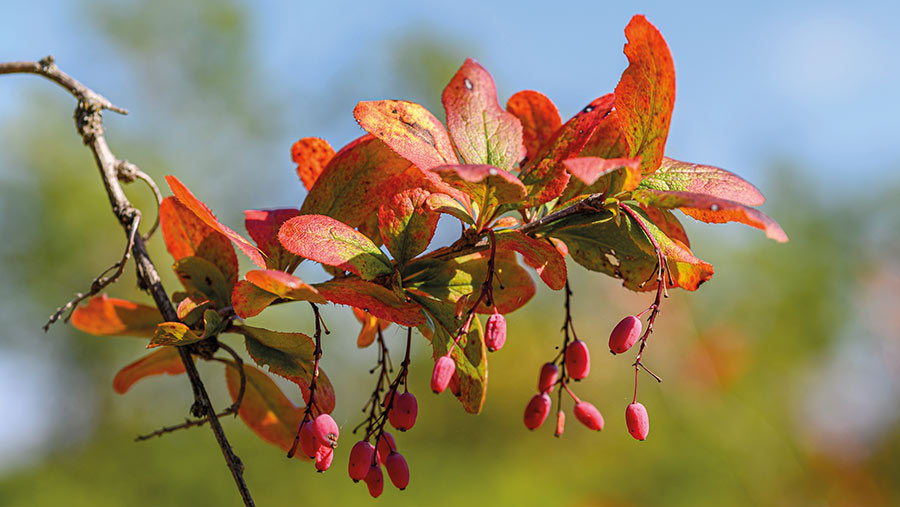Why stem rust could be back in wheat crops and what to do about it
 Black stem rust © Nigel Cattlin/Alamy Stock Photo
Black stem rust © Nigel Cattlin/Alamy Stock Photo There are several measures that farmers can take to protect their wheat crops from stem rust disease, which is on the brink of re-establishing itself in UK fields.
Conditions have become more conducive to the disease, with warmer summers, a move to later maturing wheat varieties and more spring cropping in rotations.
The disease, which can reduce yields by up to 90% in severe cases, was once common in western Europe, with frequent epidemics.
See also: The rare moth putting sugar beet yields at risk this autumn
However, since the last big epidemic in 1955, there were several decades when it hadn’t been seen in the UK, says Diane Saunders, a plant pathologist at the John Innes Centre in Norwich.
In 2013, the UK saw its first recorded case in nearly 60 years. Since then, stem rust has been observed at several locations, generally affecting just one to two plants in each case.
But this all changed last summer when it was the most widespread since 1955.
Prof Saunders knows of sites across 12 different English counties and Wales and the AHDB reported earlier this summer that its Recommended List trial site in Lincolnshire had plants showing the classical stem rust symptoms on stems, leaves, and ears.
So where has it come from and could this spell its return? To answer this, you need to look at its life cycle.
Prof Saunders points to its very complex life cycle, with five different spore releasing stages (see panel) and two different plant hosts – cereals and barberry bushes.
Possible source of 2022 outbreak
With no evidence of local infection from barberry bushes, the thinking is that the disease is moving long distances on wind from other parts of the world as urediniospores.
“This year has been unusual and we have seen more Saharan dust clouds – these may help move spores to the UK.”
She noted that in mid- to late June, there was one notable cloud and this could have picked up these urediniospores from North Africa or anywhere along the cloud’s route through Europe to the UK.
About two to three weeks before stem rust reports started to come in, there was a particularly big Saharan dust cloud that moved north to the UK and she believes this may have led to widespread infection this summer.
Another change this year is that up to 2021, all UK outbreaks were caused by a single race of stem rust, but researchers are now seeing more races in the UK.
So what was the reason the epidemics stopped in the 1950s? One key factor was a focus on managing the alternative host of the disease – common barberry (Berberis vulgaris).

Berberis vulgaris © rusgrus01/Adobe Stock
There was legislation (such as in Sweden) and removal campaigns to limit the shrub in wheat-growing areas.
For example, in the US, a removal campaign ran from 1918 to the 1970s, where in just the first 15 years of the campaign 18 million barberry bushes were removed.
This was effective in reducing outbreaks by removing a local source of infection.
The shrub was also largely removed across England up until the early part of the 20th century.
But that is now a distant memory and the numbers of these bushes have started to increase. Some of these have been planted in efforts to conserve the Barberry Carpet moth, an endangered species.
To examine the potential hazard of barberry as a source of inoculum, Prof Saunders’ team have looked at bushes in several locations in the east of England since June 2017.
Stem rust life cycle
The fungus that causes stem rust has several spore stages.
It requires wheat and barberry hosts to complete its life cycle.
The pathogen also requires high temperatures (the optimum temperature is above 20C)
Five spore-releasing stages:
Urediniospores
In the UK, airborne urediniospores generally originate from south-west Europe and North Africa. These spores, when air movements are appropriate, cause initial infection on wheat.
Teliospores
Relatively late in the season, black elongated pustules containing the teliospores develop, mainly on the stems. These spores overwinter on wheat stubble.
Basidiospores
Eventually, teliospores produce secondary spores – basidiospores – that infect barberry, where the pathogen enters a sexual phase.
Aeciospores
On barberry, aeciospores are produced that can infect crops near field edges very late in the season.
Uredospores
In wheat, infection by aeciospores gives rise to the uredospore stage. This stage is associated with typical symptoms on wheat – orange/brown sporulating pustules, which occur in stripes on leaves and stems.
Prof Saunders highlights that the disease was present in a bush that was less than 1m from a barley crop, that subsequently got infected.
This indicates stem rust is completing its life cycle and overwintering in the UK.
To help identify high-risk bushes, the John Innes Centre developed a tool farmers can use. They enter the location of current bushes and using current weather data the tool will calculate how far spores could travel from a barberry bush.
This will help estimate how far away bushes need to be planted and enable targeted monitoring of higher risk barberry bushes close to cereal crops.
Breeding
Moving to the role of varietal resistance, the John Innes Centre worked with Niab to look at 43 varieties on the AHDB Recommended List.
Inoculation trials in glasshouses revealed that 80% were very susceptible to stem rust.
Further work in South Africa on adult plants, where the disease is naturally present, classed all 58 UK varieties as susceptible.
“So we don’t have much resistance in current UK varieties.”
Drilling date
Planting early can help prevent epidemics, Prof Saunders says. Wheat stem rust only infects wheat in the summer months, so if plants are greener for a shorter period, the risk is lower.
However, modern high-yielding varieties tend to stay greener longer, into the July/August danger zone.
“The trend to later maturing varieties on the RL may influence incidence of stem rust in future,” she warns.
Wetter autumns could also increase risk if farmers are forced to abandon drilling and go for a spring wheat instead, as seen in Ireland in 2019.
Again, spring varieties mature later and push crops into the July/August stem rust danger zone.
“More spring cropping creates conditions for increased number of outbreaks seen in the UK.”
Fungicide
Finally, the good news is that chemistry seems to be effective. Outbreaks are only being seen on untreated areas of winter wheat.

